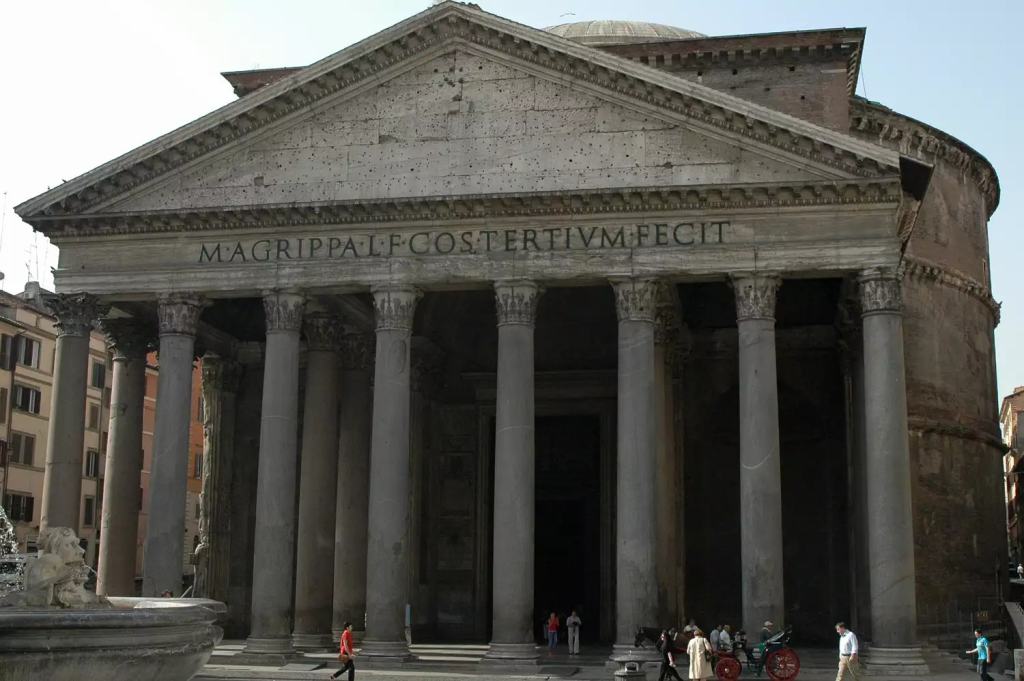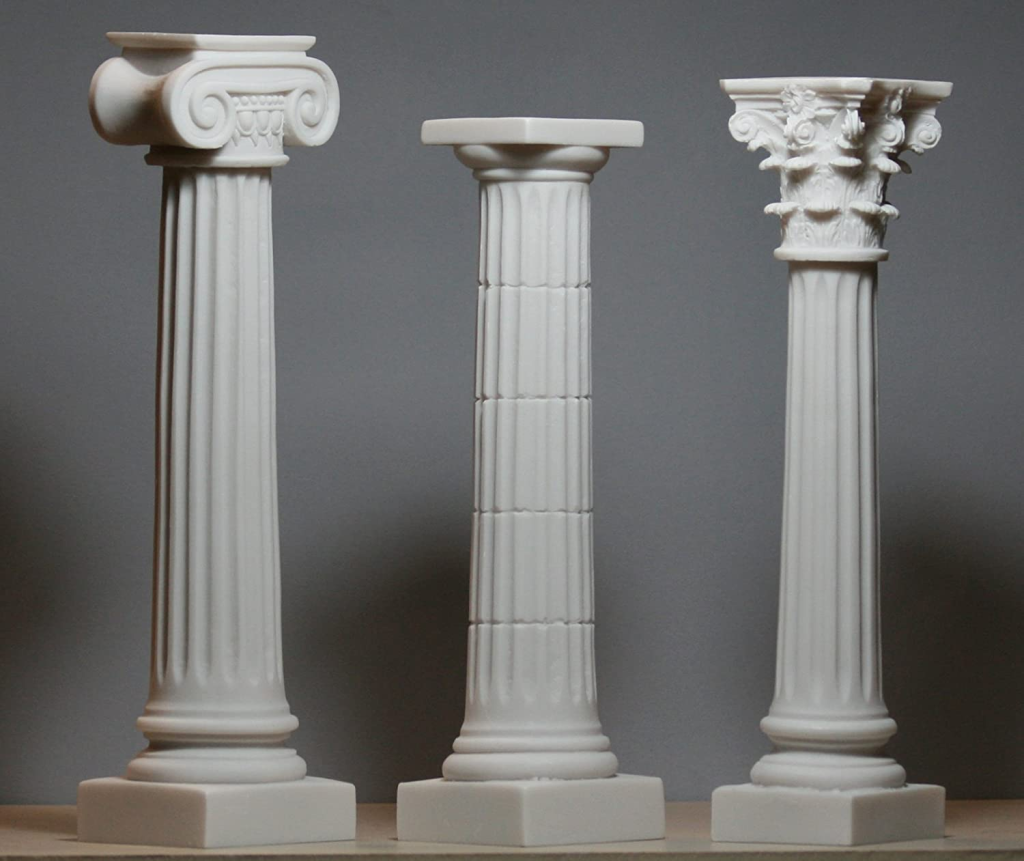We start with prehistoric Times

Goebekli Tepe in present-day Turkey is a good example of archaeological architecture. Before history was recorded, people built mounds, stone circles, megaliths and structures that often puzzle today’s archaeologists.
3,050 BCE to 900 BCE — Ancient Egypt

In ancient Egypt, powerful rulers constructed monumental pyramids, temples, and shrines.
850 BCE to CE 476 — Classical

Classical architecture refers to the style and design of buildings in ancient Greece and ancient Rome. Classical architecture has informed our approach to building in Western colonies around the world.
700 to 323 BCE — Greek:

The Doric column was first developed in Greece and it was used for great temples, including the famous Parthenon in Athens.
323 to 146 BCE — Hellenistic: When Greece was at the height of its power in Europe and Asia, the empire built elaborate temples and secular buildings with Ionic and Corinthian columns. The Hellenistic period ended with conquests by the Roman Empire.
44 BCE to 476 CE — Roman: The Romans borrowed heavily from the earlier Greek and Hellenistic styles, but their buildings were more highly ornamented.
Much of this ancient architecture is in ruins or partially rebuilt. Virtual reality programs like Romereborn.org attempt to digitally recreate the environment of this important civilization.
527 to 565 — Byzantine
:max_bytes(150000):strip_icc():format(webp)/Byz-hagia-eirene-497315595-crop-583511395f9b58d5b19655e7.jpg)
After Constantine moved the capital of the Roman empire to Byzantium (now called Istanbul in Turkey) in 330 CE, Roman architecture evolved into a graceful, classically-inspired style that used brick instead of stone, domed roofs, elaborate mosaics, and classical forms. E
800 to 1200 — Romanesque
:max_bytes(150000):strip_icc():format(webp)/romanesque-sernin-56a02c4c3df78cafdaa0697d.jpg)
As Rome spread across Europe, heavier, stocky Romanesque architecture with rounded arches emerged.
1100 to 1450 — Gothic
:max_bytes(150000):strip_icc():format(webp)/Chartres-528951782-crop-57df6a545f9b586516c98386.jpg)
Early in the 12th century, new ways of building meant that cathedrals and other large buildings could soar to new heights. Gotico became characterized by the elements that supported taller, more graceful architecture
1400 to 1600 — Renaissance
:max_bytes(150000):strip_icc():format(webp)/architecture-renaissance-LaRotonda-Palladio-Maria-WC-crop-5ad7e0cc0e23d90036540145.jpg)
A return to Classical ideas ushered an «age of awakening» in Italy, France, and England. During the renasaince architects and builders were inspired by the carefully proportioned buildings of ancient Greece and Rome.
1600 to 1830 — Baroque
:max_bytes(150000):strip_icc():format(webp)/versailles-680783213-crop-5825fc173df78c6f6ac1fc84.jpg)
Early in the 1600s, an elaborate new architectural style lavished buildings. What became known as Baroque was characterized by complex shapes, extravagant ornaments, opulent paintings, and bold contrasts.
1650 to 1790 — Rococo
:max_bytes(150000):strip_icc():format(webp)/architecture-rococo-stcatherine-508621707-5bd1e60346e0fb0051580ab2.jpg)
1730 to 1925 — Neoclassicism
:max_bytes(150000):strip_icc():format(webp)/architecture-neoclassical-uscapitol-AOC-crop-5ad8089104d1cf00373e9105.jpg)
By the 1700s, European architects were turning away from elaborate Baroque and Rococo styles in favor the restrainement of neoclassism
1890 to 1914 — Art Nouveau
:max_bytes(150000):strip_icc():format(webp)/architecture-artnouveau-HotelLutetia-524929510-5ada10eea9d4f9003dbc7da6.jpg)
Known as the New Style in France, Arte neveou was first expressed in fabrics and graphic design. The style spread to architecture and furniture in the 1890s as a revolt against industrialization turned people’s attention to the natural forms and personal craftsmanship of the Arts and Crafts Movement.
1895 to 1925 — Beaux Arts
:max_bytes(150000):strip_icc():format(webp)/garnier-parisopera-500191203-crop-58ae60113df78c345b9e61b0.jpg)
Also known as Beaux Arts Classicism, Academic Classicism, or Classical Revival, Beaux Arts architecture is characterized by order, symmetry, formal design, grandiosity, and elaborate ornamentation.
1905 to 1930 — Neo-Gothic
:max_bytes(150000):strip_icc():format(webp)/architecture-neogothic-tribune-71447573-crop-5ad80f3c642dca003683e601.jpg)
In the early 20th century, medieval Gothic ideas were applied to modern buildings, both private homes and the new type of architecture called skyscrapers.
1925 to 1937 — Art Deco
:max_bytes(150000):strip_icc():format(webp)/chrysler-171575194-56a02f875f9b58eba4af490d.jpg)
With their sleek forms and ziggurat designs, Art Deco architecture embraced both the machine age and ancient times. Zigzag patterns and vertical lines create dramatic effect on jazz-age, Art Deco buildings.
1972 to Present — Postmodernism
:max_bytes(150000):strip_icc():format(webp)/postmodern-220celebrationplace-5663cc0e5f9b583dc3762cde.jpg)
A reaction against the Modernist approaches gave rise to new buildings that re-invented historical details and familiar motifs.
1997 to Present — Neo-Modernism and Parametricism
:max_bytes(150000):strip_icc():format(webp)/hadid-468889296-57a9ba7a5f9b58974a223c71.jpg)
Throughout history, home designs have been influenced by the «architecture du jour.».
